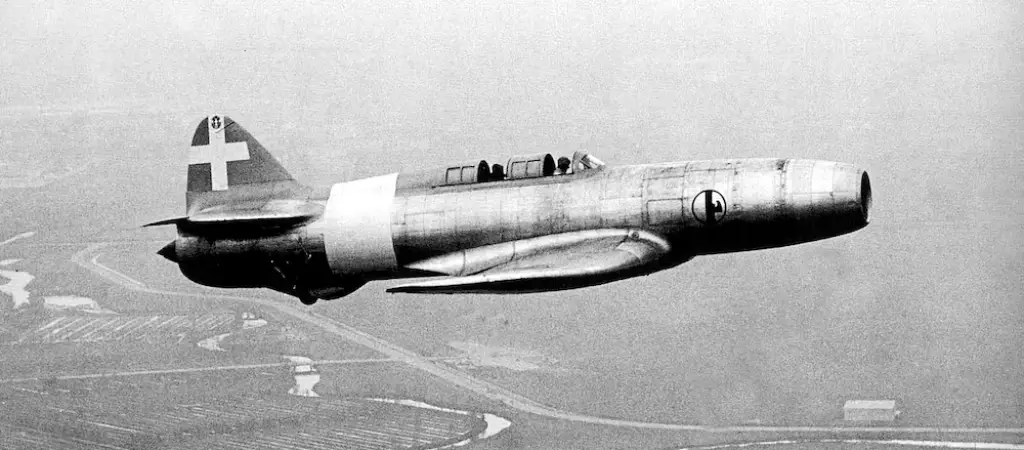Caproni Campini N.1 Was Italy’s First Jet Plane
The Caproni Campini N1 jet was the first jet to come out of Italy. It was the world’s second jet plane. The Caproni Campini N1 was the brainchild of Secondo Campini, who developed the jet with the help of the Caproni aircraft manufacturing firm.

Testing the thermojet engine of the N1. Engineer Secondo Campini is superimposed on the top left.
Secondo Campini presented the Italian Air Ministry with a design for what he called a “thermojet” engine in 1931. Three years later, on May 2, 1934, the Air Ministry signed a contract with Campini. He was to build two test airplanes by September 31, 1936. Campini was unable to build the aircraft on his own, so he enlisted the help of the Caproni aircraft manufacturing firm.
Two Prototypes Built
- Caproni-Campini CC.1 (single seat aircraft)
- Caproni-Campini CC.2 (two seat aircraft)
Thermojet vs Gas Turbine
Campini’s thermojet engine was different from a gas turbine engine, or “jet engine,” which is typically seen in other jets both then and now. The main difference between Campini’s thermojet engine and the traditional jet engine is essentially the presence of a piston engine in lieu of a turbine. When the Caproni Campini N1 was built, the intake of this unusual engine was situated at the nose of the aircraft, while the exhaust was expelled at the very rear. This left the Caproni Campini N.1 looking like a long tube with wings and a cockpit.

The Caproni Campini N1 during flight trials.
Campini and Caproni were unable to meet the deadline for their two test planes. However, the Italian Air Ministry was willing to extend it. The first plane was ready to fly on August 27, 1940. The Caproni Campini N1 was a single monoplane that weighed roughly 8,025 pounds. It was just less than 40 feet long, had a height of 15.4 feet and a wingspan of 52 feet. It was able to reach an altitude of 13,300 feet and had a maximum speed of 223 miles per hour. The second plane flew on April 11, 1941.
Performance Issues with the N.1
While the design of the Caproni Campini N1, or more specifically the thermojet engine, was interesting, it was not worthy of further development (Military Factory). The gas turbine engine was much more useful for military applications. The Caproni Campini N1 lost engine power the higher it ascended, which rendered it useless for any practical use. It was tested as it was meant to be, but it was never developed further or fitted with weapons. After World War II, the Caproni Campini N1’s were placed in museums.

The Caproni Campini N1 as it looks today in a museum.
The Campini-Caproni proved that Italy could build a jet and an innovative one at that. Unfortunately, it was beaten by the Germans in both timing and performance. One of the prototypes is housed at the Museum of Science and Technology in Milan today. The other N1 is located at Vigna di Valle Italian Air Force Museum, on the lake Bracciano, near Rome.
[wpsm_video schema=”yes” title =”Caproni Campini N.1″ description =”Original footage of the testing of the N.1.”]https://youtu.be/bNz1zZSozPA[/wpsm_video]
Specifications
| Model | Caproni Campini N.1 |
|---|---|
| Crew | Caproni-Campini CC.1 (1 Crew) Caproni-Campini CC.2 (2 Crew) |
| Length | 43 ft (13.1 m) |
| Wingspan | 52 ft (15.85 m) |
| Weight | Empty: 8,024 lb (3,640 kg) Max: 9,250 lb (3,640 kg) |
| Height | 15.5 ft (4.7 m) |
| Engine | One Isotta Fraschini L.121 R.C.40 engine (900 hp) Three-stage, variable-pitch axial compressor motorjet |
| Max Speed | 233 mph (375 km/h) |
| Max Ceiling | 13,123 ft (4,000 m) |
| Armament | None |